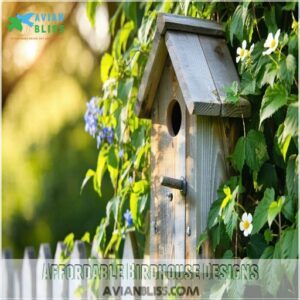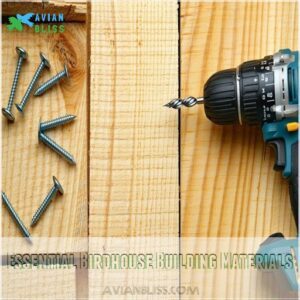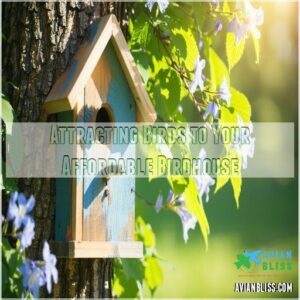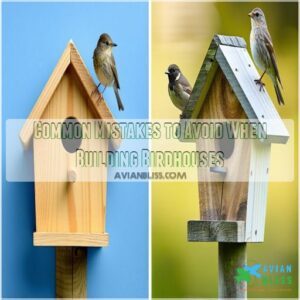This site is supported by our readers. We may earn a commission, at no cost to you, if you purchase through links.
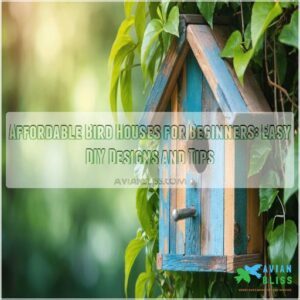
Use untreated wood like cedar or pine for a safe, durable home. Recycled materials, such as old license plates or mason jars, can also make creative options. Budget kits with pre-cut pieces simplify the process, ensuring easy assembly.
Focus on functionality—birds prefer cozy, well-placed houses over fancy designs.
Remember, placing the house five to ten feet high and away from predators is key.
With the right build, you’ll soon have feathered neighbors! Curious about tips to keep them around longer? Stay tuned.
Table Of Contents
Key Takeaways
- Use untreated wood like cedar or pine for a safe, durable birdhouse that won’t harm birds.
- Focus on simple, functional designs with proper ventilation, drainage, and an entrance hole size that matches the bird species you want to attract.
- Keep costs low by reusing materials like scrap wood, mason jars, or old teapots, and consider affordable beginner kits for pre-cut, easy assembly.
- Place birdhouses 5–10 feet high, away from predators, and ensure regular cleaning to keep them safe and inviting for nesting birds.
Affordable Birdhouse Designs
You don’t need expensive materials to create a cozy, functional birdhouse for your backyard.
With simple designs and creative uses of recycled items, you can build one on any budget.
Simple Birdhouse Designs for Beginners
Starting out with simple bird houses? Stick to easy birdhouse plans like single-board houses or basic box designs, and consider using untreated wood like cedar for durability and bird safety learn more about best bird house designs.
Hanging birdhouses are beginner-friendly and perfect for smaller backyards.
Affordable bird houses don’t need frills—focus on functionality.
Beginner bird house kits simplify everything, giving you easy bird house plans to follow and build confidence—all without breaking the bank!
DIY Birdhouse Plans Using Recycled Materials
Got some scrap wood or an old teapot lying around? Cheap bird houses can come to life with everyday items.
Creative designs using recycled materials save money and add charm.
Try:
- Old license plates for roofs.
- Gourds as natural birdhouses.
- Mason jars as unique nesting spots.
- Wine corks for decorative elements.
- Broken furniture pieces for structure.
Budget-Friendly Birdhouse Ideas
Think cheap birdhouses can’t look great? Repurposed materials like old teapots or tin cans make fantastic foundations.
Add fun paint colors for style, and stick to simple designs for beginner bird houses.
DIY bird houses using scrap wood or bird house kits keep costs low.
Compare prices online to stretch your budget and create affordable birdhouses you’ll love.
Small Birdhouse Designs for Backyards
Often, smaller spaces need smaller birdhouses. Miniature birdhouses are perfect for smaller backyards.
These easy DIY projects offer design inspiration. For those looking for a wide variety of options, check out specific small birdhouse plans online at birdhouse plans website.
Consider Backyard bird species when choosing birdhouse plans.
House placement tips are essential for attracting birds. Small bird houses, even simple birdhouse designs, can be highly effective.
Find affordable bird houses using free birdhouse plans online. These birdhouses for beginners are a great starting point.
Essential Birdhouse Building Materials
Building a sturdy birdhouse starts with using the right materials, like untreated wood and sturdy fasteners.
Don’t cut corners with treated wood or plywood—it’s unsafe for birds and won’t last long.
Types of Wood Suitable for Birdhouses
When building birdhouses for beginners, stick to untreated pine, cedar, or cypress.
These woods balance durability, cost, and tool compatibility, making them great for affordable birdhouse plans.
Cedar’s natural rot resistance adds longevity, while pine offers versatility at a lower cost.
Skip plywood and treated lumber—they’re harmful to birds. Locally sourced wood can cut costs while adding aesthetic appeal to your DIY birdhouses.
Nails and Screws for Birdhouse Construction
Moving from wood to what holds it together, let’s talk fasteners. Choosing the right screws and nails is key for sturdy birdhouses.
- Screw sizes: Go for 1-1.5 inches for secure joints.
- Nail types: Avoid oversized nails that might split the wood.
- Fastener strength: Galvanized options resist rust, lasting longer outdoors.
Waterproofing and Finishing Materials
Finishing your birdhouse is just as important as picking the right nails.
Use exterior stains or paints to protect the wood from weather damage—light colors work best to keep nests cool.
Add a water-based sealant for extra longevity without toxic risks.
Here’s a quick guide:
| Material | Budget-Friendly Option | Best Application Method | Durability |
|---|---|---|---|
| Exterior Stains | Water-based stains | Brush or sponge | Moderate |
| Exterior Paints | Latex-based paints | Brush or spray | High |
| Sealants | Non-toxic sealants | Thin, even coat | Long-lasting |
| Budget Finishes | Upcycled paint/stain | DIY tools (sponges) | Moderate |
AVOID Using Treated or Plywood Materials
Skip treated wood and plywood when building birdhouses—they’re loaded with harmful chemicals that can harm birds.
Instead, choose sustainable, safe options like cedar or pine for your inexpensive birdhouses. These natural woods are free of toxins and last longer outdoors.
Easy DIY birdhouses or cheap birdhouse kits often use safer materials, keeping things simple and budget-friendly.
Building Birdhouses on a Budget
Building birdhouses on a budget is easier than you might think with a few smart choices.
By reusing materials and simplifying designs, you can create cozy, bird-friendly homes without breaking the bank.
Step-by-Step Instructions for Beginners
Ready to build your first birdhouse? Let’s get started!
First, choose your simple bird house plans and gather your tools.
Wood preparation is key; cut your wood accurately.
Assembly tips: use strong glue and screws.
Follow your painting guide for a weatherproof finish.
Final touches include adding a perch. Easy DIY bird houses are fun projects!
Tips for Reducing Birdhouse Building Costs
Cut costs by using salvage lumber or leftover scraps from home projects.
Free plans online simplify building inexpensive bird houses with simple designs.
Buy screws and nails in bulk or share costs with friends. Choose affordable paint options, like clearance cans, to seal your birdhouse.
Batch building birdhouses saves time and reduces materials waste—perfect for budget birdhouses!
Birdhouse Kits for Beginners
If you’re cutting costs, affordable birdhouse kits for beginners are a great start.
They include pre-cut wood, screws, and instructions, saving time and hassle. Some even offer predator guards and simple designs.
You can find these affordable kits online by searching for cheap birdhouse kits.
Look for kits using the best wood like cedar or pine.
Add personal flair with paint choices, creating fun, inexpensive bird houses that attract feathered friends easily.
Attracting Birds to Your Affordable Birdhouse
Bringing birds to your affordable birdhouse starts with understanding what different species need. From proper placement to the right entrance size, small choices make a big impact.
Choosing The Right Bird Species
Think about bird size, nesting habits, and local species before choosing your focus.
For small birds like wrens or chickadees, go with birdhouse plans for beginners featuring smaller entrance holes for predator avoidance.
Robins prefer open shelves, while regional birds may need custom designs.
Affordable birdhouse kits simplify this process, giving you options that match your backyard visitors perfectly.
Installing Birdhouses at The Right Height
Getting the height right is essential for attracting the right bird species.
For secure and effective mounting options, check out these reliable birdhouse mounting solutions.
Install your birdhouse on a pole or tree to deter predators while considering safety.
Stick to these general guidelines:
- 5-10 feet: Ideal mounting for bluebirds and small birds.
- 6-20 feet: Perfect for purple martins and regional variations.
- 4-8 feet: Great for chickadees wanting cozy, safe spots.
Entrance Hole Size and Bird Species
Matching the entrance hole size to the bird species you want attracts them faster. Use a species guide or hole size chart for accuracy.
A 1½-inch hole suits bluebirds, while 1⅛ inches works for wrens and chickadees. Larger birds need bigger openings.
Sticking to proper birdhouse plans for beginners guarantees your birdhouses for small birds are spot on.
Tips for Placing Birdhouses in Your Yard
Yard placement matters! Consider three factors: sun/shade balance, predator defense (cats!), and species choice.
For bird safety, place birdhouses at least 5 feet high. Smaller birdhouses for small birds need less height.
Birdhouse installation should be secure.
Proper birdhouse location attracts the right feathered friends. Remember, a well-placed birdhouse is key.
Common Mistakes to Avoid When Building Birdhouses
Building a birdhouse seems simple, but it’s easy to overlook critical details. By avoiding common mistakes, you’ll create a safe, durable home birds will love.
Common Design Mistakes to Avoid
Skipping proper ventilation or drainage creates a sauna instead of a cozy birdhouse.
Using materials like treated wood, which can be toxic to birds, is also a major mistake – opt for bird-safe options like untreated cedar or pine.
Too-small dimensions? Birds won’t settle.
An unstable structure? It’s a disaster waiting to happen.
Unsafe materials, like treated wood, can harm feathered tenants.
Follow solid birdhouse plans or grab a DIY birdhouse kit.
These avoidable mistakes make all the difference—even if it’s a simple birdhouse for kids.
Avoiding Predators and Pests
Preventing predators and pests starts with smart birdhouse placement and protective measures.
Use poles with baffles to stop climbing critters, and make certain the entrance hole is just the right size to block larger animals.
Regular birdhouse maintenance, like cleaning, keeps pests away.
Safe materials and secured roofs boost birdhouse security, guaranteeing your feathered guests enjoy their stay without unwelcome visitors.
Mistakes in Choosing The Wrong Materials
Using the wrong birdhouse materials can waste time and money.
Avoid wood type issues like choosing treated or plywood—it’s unsafe for birds and won’t last.
Paint dangers are real; skip dark colors that overheat.
Watch for hardware flaws in cheap bird house kits; flimsy screws fail fast.
Focus on durability concerns, especially with birdhouse building for lasting results.
Tips for Building Birdhouses That Last
Start with sturdy wood like cedar or pine—no treated lumber!
Seal cracks to fight moisture, and use durable paint in light colors to prevent overheating.
Sloped roofs shed water and last longer, while predator proofing keeps birds safe.
Affordable birdhouse kits and beginner building plans make it easy to get started.
Stick to quality birdhouse materials for years of use.
Frequently Asked Questions (FAQs)
How to make an easy bird house?
Piece of cake!" Start with a one-board DIY birdhouse.
Cut untreated pine, drill a 5-inch hole, attach sides, roof, and base.
Screw it together snugly, paint lightly, and hang it 5-10 feet high.
What is the best birdhouse to attract birds?
The best birdhouse depends on the species you want to attract.
Make certain proper entrance hole size, good ventilation, and weather-resistant materials.
For versatility, a basic wooden house with a 5-inch hole works well for most birds.
What not to do when building a birdhouse?
Building a birdhouse isn’t rocket science, but don’t use treated wood, oversized holes, or skip ventilation.
Avoid decorative perches—they invite predators.
Make it sturdy, simple, and species-specific to guarantee safety and attract the right birds.
Are bird houses a good idea?
Absolutely, birdhouses are great for attracting birds to your yard while supporting their nesting needs.
They’re easy to build, affordable, and offer a rewarding connection to nature.
Plus, it’s fun watching feathered friends move in!
How long do birdhouses last?
Don’t worry about birdhouses wearing out quickly—well-built ones can last 5-10 years.
Using untreated cedar or pine guarantees they stay durable and inviting for feathered visitors.
Keeping up with basic maintenance like repainting and repairs also guarantees they stay durable and inviting for feathered visitors.
What paint is safe for birds?
Go for non-toxic, water-based paints like acrylic or latex.
Stick to light colors—they reflect heat, keeping birds cool.
Avoid lead-based or oil-based paints, as they’re harmful. Let everything dry completely before hanging it outdoors.
Can I use recycled wood?
Recycled wood’s great for birdhouses, but make certain it’s untreated and free of chemicals. Old pallets or scrap lumber work perfectly. Just make sure it’s clean and sturdy.
When is the best time to put up a birdhouse?
Springtime sparks success for setting up birdhouses, just before birds begin nesting season.
Late winter works too, giving birds time to explore.
Avoid summer starts, as most species have already found their homes by then.
How do I clean a birdhouse?
Clean your birdhouse after nesting season ends.
Wear gloves, remove old nesting material, scrub with a 10:1 water-bleach mix, and rinse.
Let it air-dry completely before reusing.
This prevents mold, pests, and disease.
Conclusion
Building affordable bird houses for beginners doesn’t have to feel like reinventing the wheel. Stick to simple designs, use budget-friendly materials like cedar or pine, and consider creative recycled options.
Proper placement, the right entrance size, and predator-proofing will turn your backyard into a bird haven.
Avoid common mistakes like treated wood or poor ventilation to keep things safe and functional.
With these tips, you’ll create a cozy space that birds will flock to and love.

